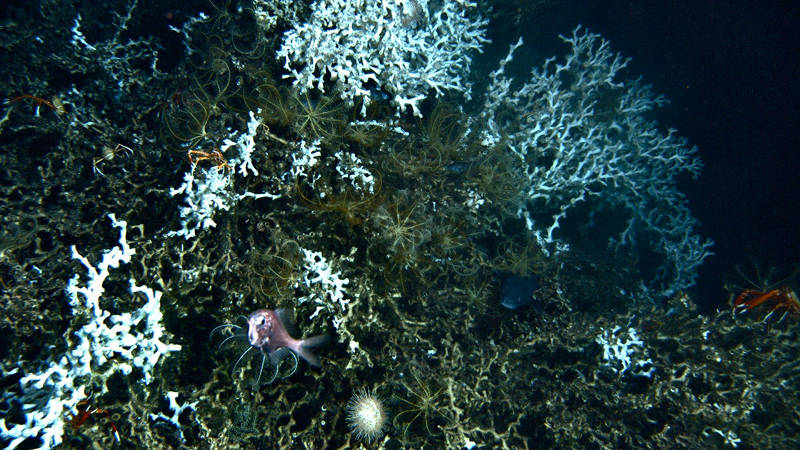
By Charles Messing - Nova Southeastern University

White living colonies of Lophelia pertusa on a build-up of dead branches, accompanied by feather stars (crinoids), red squat lobsters, a sea urchin, and fishWhite living colonies of Lophelia pertusa on a build-up of dead branches, accompanied by feather stars (crinoids), red squat lobsters, a sea urchin, and fish. Image courtesy of Lophelia II 2010 Expedition, NOAA-OER/BOEMRE Download larger version (jpg, 1.0 MB).
The Gulf of Mexico supports an extraordinary range of deep-sea habitats associated with a similarly broad diversity of seafloor features: mounds built by deep-water stony corals; limestone cliffs; glades of tree- and fan-like black corals, bamboo corals, and soft corals; brine pools and muddy plains; submerged hills and canyons; mud volcanoes; and the communities that depend on the hydrocarbon seepage that has made the Gulf the focus of extensive oil and gas production.
In some cases, resident worms and mussels depend directly on their symbiotic bacteria to extract energy from the hydrocarbons that well up from below. In others, corals grow on carbonate boulders built up by microbial activity. The boulders provide convenient perches for the corals to feed on drifting detritus and plankton, and the corals form a complex habitat of perches and shelters for a wide variety of organisms, either among the branches of the living corals or growing on dead coral branches that may form a labyrinth of nooks and crevices.
Previous expeditions to the Gulf (e.g., Lophelia II 2010: Oil Seeps and Deep Reefs) have allowed us to select sites that offer promise for our continued research into bioluminescence produced by creatures on the deep-sea floor. But, these sites offer more, including the opportunity to compare and contrast the creatures and their habitats found in different places.
On one hand, many creatures are found across much of the deep western Atlantic Ocean, from South America to Florida, the Gulf and Bahamas. But, others have more restricted ranges, and it is usually not clear why. For example, our previous research on the deep-water coral habitats in the Bahamas and off eastern Florida has revealed both important similarities and differences.
The deep-sea coral Lophelia pertusa occurs in both places, as well as throughout much of the world’s ocean basins. However, the two areas, separated by little more than 50 kilometers, support very different crinoid (sea lily and feather star) and colonial anemone faunas.
If these larger organisms differ across such a small distance (in oceanic terms), what will we find among the smaller creatures that, for example, live among the branches of the corals? Photos from the Lophelia II 2010 expedition in the Gulf offer some tantalizing clues — a combination of some Florida and Bahama characteristics.